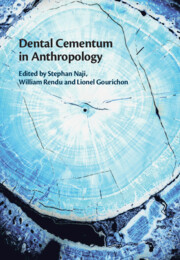Book contents
- Dental Cementum in Anthropology
- Dental Cementum in Anthropology
- Copyright page
- Dedication
- Contents
- Contributors
- Foreword
- Introduction: Cementochronology in Chronobiology
- Part I The Biology of Cementum
- Part II Protocols
- Part III Applications
- 17 Using Cementochronology to Discuss the Organization of Past Neanderthal Societies
- 18 Investigating Seasonal Competition between Hominins and Cave Hyaenas in the Belgian Ardennes during the Late Pleistocene: Insights from Cementum Analyses
- 19 Cementochronology to the Rescue: Osteobiography of a Middle Woodland Woman with a Combined Skeletal Dysplasia
- 20 Estimating a Mortality Profile of Fisher-Gatherers in Brazil Using Cementochronology
- 21 Cementochronology: A Solution to Reconstructing Past Populations’ Mortality Profiles Using Individual Age-at-Death Estimates
- 22 Assessing Age-Related Mortality at Petra, Jordan, Using Cementochronology and Hazard Modeling
- 23 Shaping Age-at-Death Distributions by Applying Tooth Cementum Analysis to the Early Medieval Graveyard of Lauchheim (Germany)
- 24 Back to the Root: The Coming of Age of Cementochronology
- Index
- Plate Section (PDF Only)
- References
17 - Using Cementochronology to Discuss the Organization of Past Neanderthal Societies
from Part III - Applications
Published online by Cambridge University Press: 20 January 2022
- Dental Cementum in Anthropology
- Dental Cementum in Anthropology
- Copyright page
- Dedication
- Contents
- Contributors
- Foreword
- Introduction: Cementochronology in Chronobiology
- Part I The Biology of Cementum
- Part II Protocols
- Part III Applications
- 17 Using Cementochronology to Discuss the Organization of Past Neanderthal Societies
- 18 Investigating Seasonal Competition between Hominins and Cave Hyaenas in the Belgian Ardennes during the Late Pleistocene: Insights from Cementum Analyses
- 19 Cementochronology to the Rescue: Osteobiography of a Middle Woodland Woman with a Combined Skeletal Dysplasia
- 20 Estimating a Mortality Profile of Fisher-Gatherers in Brazil Using Cementochronology
- 21 Cementochronology: A Solution to Reconstructing Past Populations’ Mortality Profiles Using Individual Age-at-Death Estimates
- 22 Assessing Age-Related Mortality at Petra, Jordan, Using Cementochronology and Hazard Modeling
- 23 Shaping Age-at-Death Distributions by Applying Tooth Cementum Analysis to the Early Medieval Graveyard of Lauchheim (Germany)
- 24 Back to the Root: The Coming of Age of Cementochronology
- Index
- Plate Section (PDF Only)
- References
Summary
The activities’ spatial organization of Neanderthal’s territory is often explored by studying stone tool production and use, and its economy, but not their hunting behavior. Consequently, the hypothesis that Neanderthals lacked planning potential or complex land-use strategies during the Mousterian, such as collaborative hunting and food storage, has been questioned. A cementochronology analysis of reindeer in Quina and Discoidal Denticulate in four neanderthal sites in southwestern France suggests a repeated use of specific sites at a precise time of the year for similar hunting purposes scheduled according to a year-round pattern. The development of landmark sites during the late Middle Paleolithic used every year, at the same moment, indicates that the predation system began to structure the activity’s organization within the territory in time and space and that the preys’ behavior directly impacted the social organization of the hunting groups.
- Type
- Chapter
- Information
- Dental Cementum in Anthropology , pp. 275 - 287Publisher: Cambridge University PressPrint publication year: 2022
References
- 1
- Cited by



